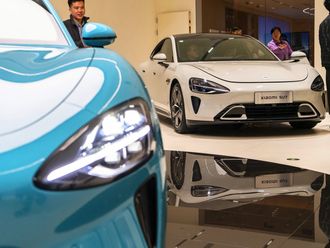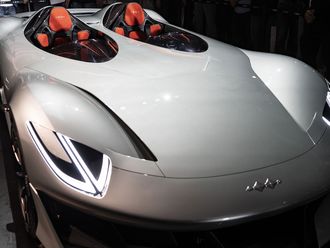
Osteoarthritis makes walking slow and sometimes painful. To see as much of Dubai as possible in four days, 75-year-old Cape Town resident, Carol Bates, opted to tour the city in a wheelchair — with a little help from resident friends.
"I don’t normally need a wheelchair," she says, "I just take things slow back home. But it allowed me to whizz around so much faster than I would have been able to do otherwise."
British friends Ann and Michael Alan had just bought a wheelchair from Dragon Mart because they were expecting a visit from a relative with partial eyesight. "When Carol told us what she wanted to do we took the opportunity to try it out," says Ann, a UK state-registered nurse.
"It has brakes, a seat belt and big wheels, which can be self-propelled if necessary. Unfortunately I didn’t notice that the foot rests do not fold back, so one has to be very careful with the passenger’s shins. It also folds up neatly and fits into the boot of the car," she adds.
Metro
Bates and her friends start off from the car park at Rashidiya Metro Station, the first station on the Red Line. Confronted with a short flight of stairs to the paying machines, they found an alternative route via a long winding sloped pathway. Once in the metro, a security staff member opens the side gate at the ticket scanners and activates their Nol cards. There are elevators and spacious ladies rooms, clearly signposted showing
access for the disabled.
Down on the platform, the protective glass doors leading onto the train are marked, indicating the area specifically for wheelchairs. "When the train arrives, these glass doors open and inside there is indeed a designated space for a wheelchair. It is easy to get in as the train is completely level with the platform — no booming mind-the-gap announcement is required here," says Ann.
Changing trains for the Green Line at Union Metro Station is tricky because of the rush of people, but Ann says, "The wheelchair works as a sort of battering ram, knocking the pushing crowds out of the way as people always try to get on before we disembark."
Despite the crowded trains, commuters readily give up their seats once they notice the wheelchair, says Bates, who ignores the stares that follow her every move. "Wheelchairs are obviously an uncommon sight in Dubai," she says. "Anyway, I was so impressed with the Metro — it works like a dream, so thumbs up to the Road Transport Authority."
Textile souq
After exiting the Al Ghubaiba metro station, progress is easy along the pavements to the textile souq, but entering the rickety shops with goods stacked to the ceiling is impossible. Hawkers readily bring out their wares anyway.
"The ground here is very uneven — I wouldn’t really expect anything less as it represents the charm of old Dubai, but you do have to lift and negotiate the wheels carefully here," says Michael.
"Wheelchair travel is a bit dodgy in the old part of the city simply because of the high, uneven pavements and no dropped kerbs, so there’s a lot of lifting up and pulling backwards," he says. "There are so many areas that are cordoned off for maintenance reasons as well, so you have to walk on the road. Luckily traffic moves at a snail’s pace in this area, so it’s not too dangerous."
Dubai Museum
Passing the Dubai Museum, the Alans decide not to take their guest in because on previous visits they found it was not wheelchair-friendly. "It’s also very dark inside, so there’s a possibility that someone might trip," says Ann.
Abra ride
The one-dirham abra ride across the Creek is easy for someone who can walk, but would be difficult without help, admits Bates, as Michael folds and carries the wheelchair on to the creaky bustling abra full of passengers. Taking a taxi to reach the other side of the Creek is an option, but they would miss the traditional buzz of activity that makes this part of the city so appealing.
"It’s quite a feat working out how to get around various obstacles, so I think only fit or experienced wheelchair-bound people could cope in this situation on their own. However, with a strong pusher anything is achievable," says Michael.
Spice souq
"Being in a wheelchair, you are at the mercy of hawkers," says Bates. "Almost every spice trader in their enthusiasm to show off their wares would snap a cinnamon stick in two and shove it under my nose for a sniff. And I actually dislike the smell of cinnamon!"
Gold souq
Not being confined to a wheelchair enables Bates to wander around the souq and into the quaint shops as and when she wants to. She also finds it easier to get out of the chair at every kerb-end
in order to cross the roads rather than be jiggled about.
"Dubai is amazing. In fact, it just blew me away. In the middle of the desert there are these fantastic buildings, a railway, straight roads and extraordinary U-turns. Visiting here is a dream come true. It has far exceeded all my expectations," says Bates.
Jumeirah Beach
When in Dubai, clicking a selfie with the Burj Al Arab in the background is a must, according to Ann. "On a weekday it is so easy to park by the seafront and walk a few steps to the wall," she says. No shade on the beach at midday in early November means a quick look around and a drive to a cool mall.
Dubai Mall
The sophisticated modern shopping malls with marbled floors, escalators, elevators and moving walkways offer a huge contrast. In fact, wheelchairs are provided at any one of the ten guest service desks within The Dubai Mall. And this feature is common to most malls across Dubai.
"Moving a wheelchair through the mall is a breeze. There are many seating areas too and features to gawp at at no cost at all," says Ann. The ice rink, souq, aquarium, shops, the diving wall fountain at the centre of the mall and the dancing fountains set to music on the Burj Khalifa Lake attract huge numbers of visitors every day.
Ibn Battuta Mall
"Having a wheelchair to wander through the fascinating 1.5-kilometre-long single storey mall was a blessing. If I have any other visitors who are slow walkers, I would happily put them in a wheelchair to save time!" says Ann.
"I found everything absolutely amazing. I could have bought any number of things in all the different sections — if I had enough money. Also the decoration was extraordinarily beautiful in all the sections, which added a great deal to the enjoyment of the experience," says Bates.
The world’s largest theme mall, designed around the travels of 14th-century Arab explorer Ibn Battuta, has a customer train costing around Dh25 a journey and wheelchairs are stashed behind the information desks.
Creek Park
What better way to end the journey than a picnic at the wheelchair-friendly Creek Park, where the visitor can carry a heavy picnic box on his or her lap.
"Our only disappointment was that the Dubai Municipality has stopped hiring out the four-seater cycle carts," says Ann. "The plan was for Michael and I to bung our visitor in the back seat while we cycled her around the park. However, we had to lie on the lawn under a palm tree and snooze instead — no hardship!" she adds.












